•Preview/Download (Free pdf, 1.1MB)
____________________________________________________________________________
•Preview/Download (Free pdf, 1.1MB)
____________________________________________________________________________
 I am finding that the biggest impedance to open textbooks is not with instructors or supply, but college administrators, government administrators, and those who provide the money, including grant foundations.
I am finding that the biggest impedance to open textbooks is not with instructors or supply, but college administrators, government administrators, and those who provide the money, including grant foundations.
Administrators’ primary job is to ensure the health, survival, and reputation of their institution. Their priority is to provide an education infrastructure that is capable of achieving the outcomes expected by formal and informal sources. They compete for funds and will avoid any activities, no matter how innovative, that will seem to risk the institution’s health, survival, and reputation. Those of us in the open textbook movement have so far failed to adequately demonstrate the low risk, the long-term value of open textbooks, and how to sustain them. For example, the loss of potential revenue from their bookstores alone is sufficient to continue with exclusivity agreements with traditional publishers. Besides, anyone providing open textbooks may be a “vaporware” organization. Traditional publishers have a solid longevity and reputation. Administrators are not risk takers.
Grant foundations’ primary job is to carry out their charter while complying with complex tax laws. Though many want innovation in both process and products, most of their money is given to status quo institutions, which makes sense since they must avoid any investments the IRS might consider as a “jeopardy investment.” They also fund projects that require approaches already established in some form. Foundations are not risk takers either.
The primary point is that the education industry and its supporting organizations are not constructed to innovate very quickly (i.e. within a generation.) What many are calling innovations is only innovative to the education industry. For those of us outside education we see the efforts and funding aimed at technological and pedagogical breakthroughs getting lost in organizational and institutional isolation and competitiveness. If they so desired all the heads of all the institutions could pull together their resources to quickly and efficiently provide open textbooks and ancillary resources.
My Solution? Demonstrate the commercial feasibility of open textbooks as a textbook competitor among the giants. Once the perceived risk is mitigated education institutions will adjust accordingly. Textbook prices will fall back into normal ranges. Economically, students and taxpayers will be much better off. And, naturally, the quality of textbooks will increase.
•Preview/Download (free pdf, 9.6 MB)
•Read Academic Reviews, Critiques, Recommendations [in process]
•Compare Contents [in process]
Order $Printed Copy $: [see author’s website]
**************************************
•Preview/Download (free pdf, 13MB)
•Order Printed Copy [see author’s website]
•View Author’s Website
 Author provides textbook and student solutions manual.
Author provides textbook and student solutions manual.•Download Textbook (free pdf, 9.6 MB)
Preview/Download Student Solutions Manual (free pdf, 1MB)
Order $Printed Copy $: [see author’s website]
**************************************
 American Book Company’s Classified Textbook Prices, 1915. $1.00 in 1915 = $21.80 in 2011.
American Book Company’s Classified Textbook Prices, 1915. $1.00 in 1915 = $21.80 in 2011.
Most Expensive Textbook: Church’s Descriptive Geometry, etc. (2 vols) $2.50 ($54.51 in 2011 $)
New University Algebra. With Answers $1.58 ($34.44) , Key to the same $1.50 ($32.70)
 In 1922 educators were looking for objective methods for evaluating textbooks:
In 1922 educators were looking for objective methods for evaluating textbooks:
Text-book selection is obviously a process of making choices, and choices can be made in many ways. It is quite possible that certain texts have been chosen not because they were better tools of instruction than other books, but because the salesman urging their adoption had a more persuasive vocabulary, more agile and plastic sales methods, or was politically more canny than his competitors. Other texts have had large sales because they were or professed to be exponents of some pedagogical doctrine which momentarily hypnotized the buying agent. Better than the above, many texts have been adopted by schools because the proper authority, having studied the matter deliberately, chose those particular books.1
Franzen and Knight categorized their criteria as shown by their quote below.
The major criteria for selection of text-books are five:
1p. 13, “Textbook Selection“, R.H. Franzen and F.B. Knight, Warwick and York, Inc. Baltimore, MD 1922.
Franzen’s and Knight’s book (pdf) is in the Supplemental Materials section below.
Order $Printed Copy $: [see author’s website]
********************************************
Broken links? Please let us know.

Will open textbooks become a sustainable alternative to traditional textbooks? (Here I use textbooks to mean both print and digital formats.) As founder of Textbook Equity I believe they will. Replacements will be slow at first, but will increase exponentially as instructors gain more confidence in the efficacy of open textbooks and come to trust the freedom that open licenses provide.
Everyone should be aware that all the parts of the supply-side of open textbooks are ready or almost ready.
Today, there are enough usable open textbooks to cover all core requirements, as well as many specialized and advanced classes. There are many organizations building inventories of open textbooks, learning modules, and learning objects. There are substantial grants funding open content creation and associated technologies. And there are many people who actively support the replacement of expensive traditional textbooks with low cost and free ones.
To produce open textbooks we find that quality content is freely available under a variety of open and free-use licenses. Inexpensive or free computer software is available to create sophisticated texts, images, and graphics. Print-on-demand services are inexpensive and easy to use. Thousands of academics are willing and able to adopt open textbooks or create their own, and students and taxpayers will save millions upon millions of dollars, providing a strong motivation to produce open textbooks.
So what business model (i.e. business processes) will make this happen? It’s quite simple, actually. There are many flavors, but one example is a business that offers the textbooks for free or very low cost in digital format while providing printed copies at cost plus a reasonable mark-up. The profits are distributed to the company for providing the service, to the authors for providing and maintaining the content, and possibly to the students for achieving a high grade in the course. These textbooks can be sold, at profit, from $15.00 to $40.00, maybe even less. Anyone can create and publish an open textbook. Anyone can make a “clone” of the top selling textbook using open content without fear of copyright violations or creating ethical issues. Other business models will work, and there will be an industry shakedown in the coming years as traditional publishers begin to feel the impact of price competition. Their current response is focused at using technology products to enter into exclusive, non-competitive agreements with colleges. I’m betting that print versions will not go away any more than did movie theaters, landlines, analog watches, or the combustion engine. Textbooks will physically shrink, and assignments will morph into a hybrid of online and paper. But paper will remain.
The challenge to growth rests on the demand-side. And that potential demand is large.
According to a National Education Statistics report there are about 1.4 million post-secondary faculty in the U.S. (2007). Given the independent nature of college instructors, this means there are 1.4 million separate decision-makers. Throw in the 328,000 graduate assistants and we are close to 2 million decision-makers. In most post-secondary institutions, I am told, the instructors are free to choose the textbook they wish to use for their class. But de facto many are bound to some degree by departmental deans, contractual obligations with bookstores, and other administrative policies.
But if they are free to adopt what they want, instructors are hesitant to adopt open textbooks because open textbooks providers do not offer the convenience of traditional textbooks, and instructors often perceive open textbooks as being less than fully reliable, comprehensive, or authoritative as traditional textbooks. In some cases, this is true. It is difficult to know where to find consistently reliable and current open textbooks. The publishers do much of the upfront screening.
My ad hoc interviews with college professors yielded this consistent criterion in selecting a textbook: Does it have all content I need for my class? Is that content current and authoritative? Does it complement my teaching style? Is it useful?
Open textbook business models, then, need to emulate the same type of authoritativeness, stability, and reliability that traditional publishers offer. This is not hard or expensive to do. I estimate that I can sell a printed open textbook identical in content for about 80% less than traditional publishers. Thus, a $140 math book would sell for $28.00. That $28.00 yields enough profit to pay the production costs, the author, and reinvestment for another textbook, and, still offer digital versions for free.
Here are other issues with open textbooks:
* Ambiguous copyright information
* Ambiguous sources of content
* Ambiguous grade level
* Poor quality writing, graphs, photos, schematics
* Outdated content
* Too granular – broken into too many “modules” or “learning units”
* Undocumented sources or appears non-authoritative
* Don’t know who else is using it
* Few or non-existent questions, problems, solutions
Notice that all of these problems can be overcome, relatively quickly and cheaply. The traditional publisher business models solved many of these problems years ago and provide excellent textbooks (in most cases). They have enjoyed many years of oligopolistic pricing and profits, but, as I attempted to demonstrate above, the proliferation of quality open content plus changes in technology have removed traditional barriers to entry. A more price competitive industry in inevitable. The education dollar can thus go further.